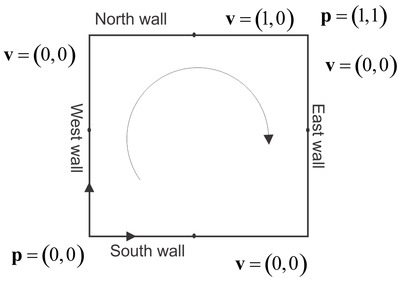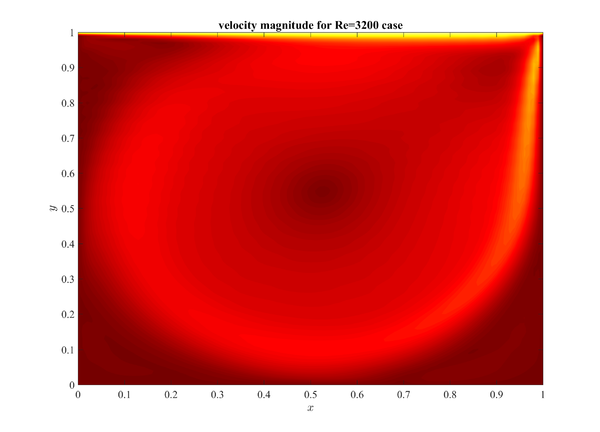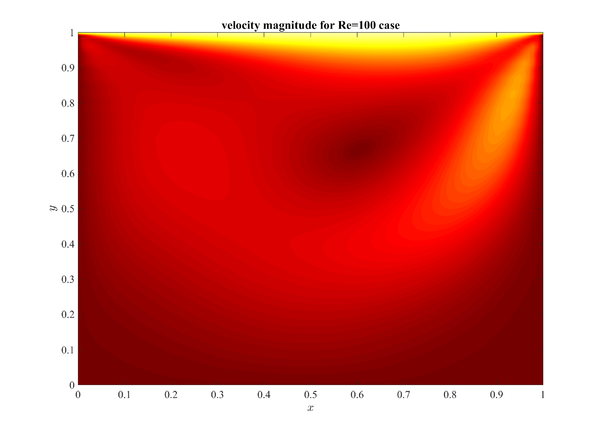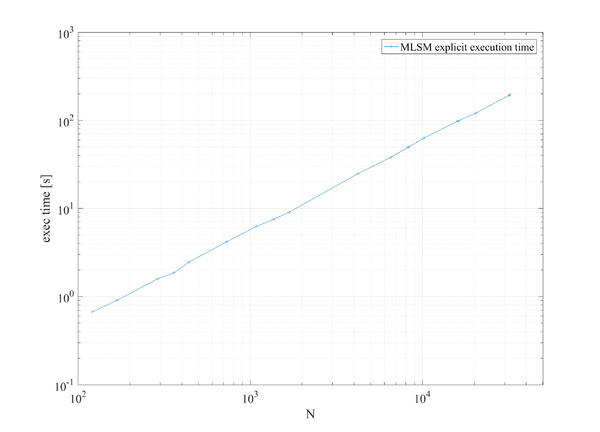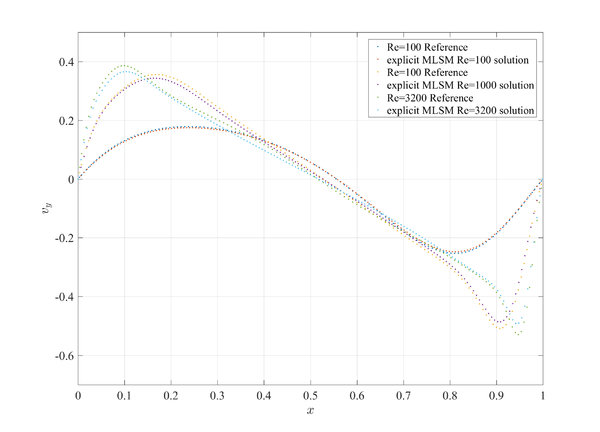Difference between revisions of "Lid driven cavity"
(→Results) |
E6WikiAdmin (talk | contribs) |
||
| (6 intermediate revisions by 2 users not shown) | |||
| Line 1: | Line 1: | ||
| + | {{Box-round|title= Related papers | | ||
| + | [https://e6.ijs.si/ParallelAndDistributedSystems/publications/29512743.pdf G. Kosec; A local numerical solution of a fluid-flow problem on an irregular domain, Advances in engineering software, vol. 120, 2018 [DOI: 10.1016/j.advengsoft.2016.05.010]] | ||
| + | }} | ||
| + | |||
| + | Click here to return back to [[Fluid Mechanics]] | ||
| + | |||
=Intro= | =Intro= | ||
| − | |||
| − | |||
Let's try MLSM and described solution procedures first on a lid driven cavity problem that stands for a standard benchmark test for validation of the fluid flow solvers. It has been proposed in 1982 and since then solved by many researchers with wide spectra of different numerical methods. The test is still widely studied and used for validation of novel methods and numerical principles. Case is schematically presented in <xr id="fig:lid_driven_scheme"/> followed by few basic analyses, just to show that things work as they should. Details about comparison can be found in [http://comms.ijs.si/~gkosec/data/papers/29512743.pdf paper] | Let's try MLSM and described solution procedures first on a lid driven cavity problem that stands for a standard benchmark test for validation of the fluid flow solvers. It has been proposed in 1982 and since then solved by many researchers with wide spectra of different numerical methods. The test is still widely studied and used for validation of novel methods and numerical principles. Case is schematically presented in <xr id="fig:lid_driven_scheme"/> followed by few basic analyses, just to show that things work as they should. Details about comparison can be found in [http://comms.ijs.si/~gkosec/data/papers/29512743.pdf paper] | ||
| Line 11: | Line 15: | ||
=Code= | =Code= | ||
| − | The snippet of the MLSM code for an explicit ACM method with CBS looks like: (full examples, including '''implicit versions''', can be found under the examples in the code repository | + | The snippet of the MLSM code for an explicit ACM method with CBS looks like: (full examples, including '''implicit versions''', can be found under the examples in the [https://gitlab.com/e62Lab/medusa code repository]). |
<syntaxhighlight lang="c++" line> | <syntaxhighlight lang="c++" line> | ||
for (int step = 0; step <=O.t_steps; ++step) { | for (int step = 0; step <=O.t_steps; ++step) { | ||
// Navier-Stokes | // Navier-Stokes | ||
| − | for (auto | + | for (auto c:interior) |
// Navier-Stokes | // Navier-Stokes | ||
v2[c] = v1[c] + O.dt * ( - 1/O.rho * op.grad(P1,c) | v2[c] = v1[c] + O.dt * ( - 1/O.rho * op.grad(P1,c) | ||
| Line 29: | Line 33: | ||
} | } | ||
</syntaxhighlight> | </syntaxhighlight> | ||
| + | |||
=Results= | =Results= | ||
| − | |||
| − | |||
| − | |||
| − | |||
| − | |||
| − | |||
| − | |||
| − | |||
| − | |||
| + | [[File:lid_driven_contour_Re3200.png|600px]][[File:lid_driven_contour_Re100.png|600px]] | ||
| − | |||
| − | |||
| − | |||
| − | |||
| − | + | [[File:lid_driven_explicit_exec_time.png|600px]][[File:lid_driven_explicit_convergence.png|600px]] | |
| − | [[File:lid_driven_explicit_convergence.png|600px]] | ||
| − | |||
| − | |||
Latest revision as of 18:26, 23 October 2022
Related papers
Click here to return back to Fluid Mechanics
Intro
Let's try MLSM and described solution procedures first on a lid driven cavity problem that stands for a standard benchmark test for validation of the fluid flow solvers. It has been proposed in 1982 and since then solved by many researchers with wide spectra of different numerical methods. The test is still widely studied and used for validation of novel methods and numerical principles. Case is schematically presented in Figure 1 followed by few basic analyses, just to show that things work as they should. Details about comparison can be found in paper
Code
The snippet of the MLSM code for an explicit ACM method with CBS looks like: (full examples, including implicit versions, can be found under the examples in the code repository).
1 for (int step = 0; step <=O.t_steps; ++step) {
2 // Navier-Stokes
3 for (auto c:interior)
4 // Navier-Stokes
5 v2[c] = v1[c] + O.dt * ( - 1/O.rho * op.grad(P1,c)
6 + O.mu/O.rho * op.lap(v1, c)
7 - op.grad(v1,c)*v1[c]);
8 }
9 // Mass continuity
10 for (auto i:interior) {
11 P2[i] = P1[i] - O.dl * O.dt * O.rho * op.div(v2,i) + O.dl2 * O.dl * O.dt * O.dt * op.lap(P1,i);
12 }
13 v1.swap(v2);
14 P1.swap(P2);
15 }
Results
